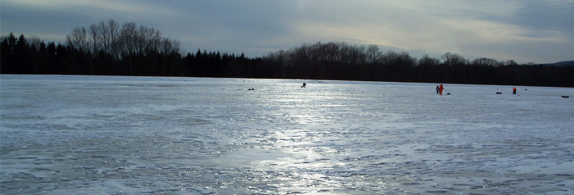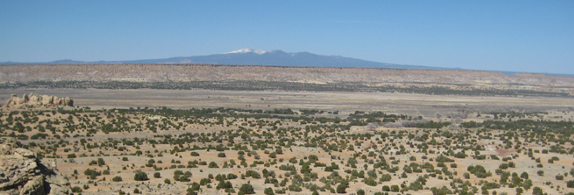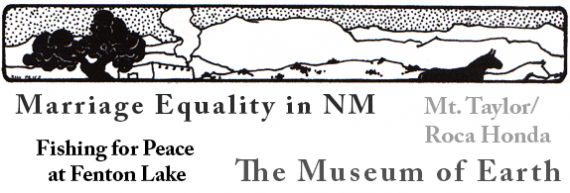Fenton Lake and Fishing for Peace

Some of the real fishermen gave us quizzical looks. There we were, on our little canvas folding seats, in the middle of frozen Fenton Lake in coldest January, with no visible means of fishing.
Our companions had drilled holes in the ice and were patiently waiting for trout to strike their bait. Like them, we were bundled against the cold, but had no hole in the ice before us.
We were meditating that day. But started to get the giggles when we imagined those fisherman thinking to themselves, “poor old folks, they probably think the fish are going to bust through the ice and beg to be eaten.”
Fenton Lake is one of those New Mexican places where you can escape the pressures of urban life while still having the pleasures of the good company of fisherfolk and their picnicking families. The Lake is an hour and a half from Albuquerque in the Jemez Mountains. The drive alone can help you detach from the pressures of the world. And if you’re lucky, the Jemez Pueblo food stands will be open and you can further unwind with sublime tamales and thin prune pie.
That January on the frozen lake, we were fishing for peace, counting our breaths with the mountains all around us, in the company of quizzical fisherman, but folks of a kind disposition. We had a long time on the ice, focused and smooth and deeply happy.
Our little community of fisherman and meditators had a gentle feel to it. We didn’t ask each other many questions. But we were all smiles when we nodded and said hello. And why not? After all, all of us out there, holes in the ice or not, were just fishing for peace… together.
A Day of Days in New Mexico

August 27, 2013 will be remembered by many of us in New Mexico as the day love triumphed for all of us.
It was such a simple and beautiful moment, but one entangled for centuries in all the miseries and horrors a society can drag from its depths. On August 27th, that mass of trouble seemed to be just blown away like so much dust.
When a state District Judge Alan Malott in Santa Fe declared that the New Mexico Constitution makes discrimination based on sexual orientation unconstitutional, he basically said that “gay marriage” was legal in New Mexico.
Malott is a judicial hero in my book, as is Dona Ana County Clerk Lynn Ellins, and the five other county clerks who took his ruling to heart and started issuing marriage licenses to same sex couples.
In six counties, people of the same gender, who love each other and want to spend their lives together in a way that’s recognized by the formal structures of our society, can be legally married, overcoming millennia of bigotry and violence against them.
This is a time to be proud and grateful to be a New Mexican.
But wouldn’t you know it, now a bunch of Republican state legislators are playing the role of killjoy homophobes, once again, trying to overturn Judge Malott’s ruling. When will these troglodytes get it? Their hateful obstruction of human kindness and compassion and love is sinking their party into the muck of bigotry and prejudice. What am I saying? It’s already in it.
The GOP in New Mexico is showing us all what it really is – a haven for haters.
Maybe sometime in the future we’ll see anniversary announcements of women who have been married for sixty years to women, and of men who have been married to men for as long. We’ll see photographs of love beaming into cameras, love secure at last in the eyes of the state thanks to the events of August 27th.
I’m sure the forces of bigotry will make more moves to threaten and destabilize these marriages. This coterie of haters will be vexing but unsuccessful. I am equally sure that love is here to stay and will prevail even in the chaotically angry world we live in.
Legal haggling will continue. But let it be drowned out for the moment by the hoorays and hurrahs of those of us tossing rice and throwing flowers at our beloved friends and relatives whose love has been sanctioned in New Mexico, who have received marriage licenses, and who are married now! Our joy and delight go out to them. And if anyone tries to take this away, our fury will be on their heads.
The Museum of Earth

In a remote area west of Los Lunas, giant sea scorpion fossils extrude from the walls of an arroyo. Sources won’t tell you where they are, and they can’t say what they look like. They’re just there somewhere, lost to all but science. But my imagination doesn’t need much seeding.
Out in Chaco Canyon, the nacre from sea shells can be seen glinting in the sunshine like the clasps on Aphrodite’s sandals. And sharks teeth are littered on the ground from many millions of years ago when a vast inland sea covered the state and most of the mountain west. Those oceans must have had giant sea scorpions chasing prey like T.S. Eliot’s “pair of ragged claws/Scuttling across the floors of silent seas.”
The monster scorpions remain safe from hunters. But they do bring to mind another moment in an arroyo where an extrusion took me away across imagination’s mental seas. In the middle of the ruins of the Pueblo of San Marcos on the edge of the Galisteo Basin in a deep arroyo that a number of us were traversing as we examined the remains of this vast adobe city, which turned out to be, at this point, great mounds of dirt. This Galesteo Pueblo was not built of stone like Chaco ruins in the Four Corners. And, if truth be known, it was, if not a disappointment, a place that required a slight attitude adjustment.
Trudging up an arroyo, with big clouds overhead, darkened the spirit with thoughts of flash flooding until from the corner of your eye you see protruding from the arroyo wall, which hems you in, four or five courses of adobe brick maybe twenty feet long. It’s was like finding the skeleton of the old pueblo and every bit as exciting at the time as stumbling across a giant scorpion fossil, though not as foreboding.
San Marcos, it is said, was the pueblo that “guarded” the great Cerrillos turquois mine, known as Chalchihutitl, which traded its highly prized oceanic green stone all the way to the Maya in southern Mexico, long before Europeans arrived.
The massive pueblos in the Galisteo region – San Christobal, Pueblo Largo, Pueblo Colorado, San Lazaro, and Colina Verde -- held at their peak as many as 15,000 people. The southern Tewa started to build them in the 1200s. They were abandoned and reinhabited numerous times, but were finally deserted when the Spanish re-conquered New Mexico in 1692 and ended the Pueblo Revolt started a dozen years earlier.
What change leaves behind is the stuff of awe. Time and weather curate wonders in the museum of earth. Ant hills, the construction leavings from their underground cities, are piled up from the change of mountains.
A white bearded old man who used to walk up and down the middle Rio Grande Valley in the winter knew what gems the ants had lugged up from their excavations in the mountains’ debris.
He’d put his findings in little glass vials and, the story has it, give them away at Christmas time. The thrill was that the little vials were filled with currant red garnets, maybe two dozen of them in each. To open the vial and pour those stones into your palm felt like dabbling your hand in the baskets of gem stones in Ali Baba’s secret cave.
For years, a bunch of us would scour wintertime ant hills for garnets, never finding many, but always uncovering the tiny jawbones and femurs of critters the ants had scoured clean. These hunts took on airs when one of our number, behind our backs, put her diamond ring into an ant hill’s dirt, prompting one of us, me I think, to exclaim mightily of the find glittering just “over there.”
The old Santa with his vials of garnets has never disappeared from our family mythology. We still imagine him smiling at the luck of the ants when they reward his wondering mind with a speck of the mountains’ treasure.
Roca Honda and an Understated Sacredness

A struggle is taking place on Mount Taylor between two worldviews, two ways of seeing humankind’s relationship to the natural world.
To over simplify, one way sees nature as having no intrinsic value until it is put to use to serve human needs or desires. It sees nature as a slave, as something to be conquered, as something from which to extract or pillage value and then discard as a broken and worthless carcass. It is a worldview that dominates western civilization but does not have a universal following. Rachael Carson, and those of us who believe in the ecological connectedness of all living things, have worked to overturn this dominating view. We have not been totally unsuccessful.
The other way sees humankind and the natural world as inseparable, as eternally bonded in a sacred relationship in which the natural world is holy and humanity’s place within it as sacramental not exploitive, respectful and loving, not manipulative and greedy -- or so it seems to me.
One worldview is what most Americans grew up with, and many came to oppose once we understood its moral implications.
The other is a worldview that only native people fully grasp, a sensibility that is so foreign to most EuroAmericans, other than the ecologically minded, that they can’t find a sympathetic lens through which to see it.
This struggle of worldviews has coalesced around various bureaucratic maneuvering and timetables over a mining permit for the proposed Roca Honda uranium mine. And the differences are as stark as they can get – trucks, highways, earth movers, piles and piles of waste versus shrines of pebbles placed in inconspicuous circles, medicinal plants gently protected and gathered, and a pattern of understandings of respect and a delicate moving on the earth.
It’s a matter of exploitation verses what Pueblo art historian and architectural theorist Rina Swentzell calls “an understated sacredness.”
Uranium mining, and the uses of uranium, epitomize the death wish of western civilization. It’s a way of life and an economy that has come to thrive on waste, on extracting and transforming natural materials too powerful to be controlled. It’s a way of life that thrives on exploiting others, despoiling land in the service of mere profit, and on science and technology applied without conscience by amoral, soulless corporations whose single reason for existence is to make money from something they can rip from the earth for virtually no cost compared to profits.
Uranium with its poisonous waste and its horrific uses – for radioactive weapons and power generation that uses the most dangerous materials on the planet to boil water – is being touted as an economic savior for the Grants Mineral Belt region, which includes Laguna and Acoma Pueblos and parts of Navajo country.
The Roca Honda uranium mine proposed for Mt. Taylor could be the largest of its kind in America, and it’s not even owned by Americans, but rather by foreign companies – Strathmore Corporation of Canada and Sumitomo Corporation of Japan. If its permit applications are approved by the U.S. Forest Service, these companies will despoil, intentionally or not, one of the most significant holy places of the Pueblo and Navajo worlds. There’s been no uranium mining since 2002 in New Mexico when a company stopped extracting dissolved uranium from waste water flooding around Ambrosia Lake north of Grants.
When mining companies drive their trucks and dig their mine shafts on Mount Taylor they can’t see the religious shrines and healing plants that Pueblo and Navajo people can because, unlike the arrogance of those companies, Native Americans mark their shrines with delicate and almost invisible care.
“At the center of the Pueblo belief system is the conviction that people are not separate from nature and natural forces. This insoluble connection with nature has existed from the beginning of time. The goal of human existence is to maintain a wholeness or oneness with the natural universe,” Rina Swentzell writes in her essay on the understated nature of Pueblo religious symbolism in Anasazi Architecture and American Design.
Sacred spaces are “marked by an inconspicuous stone or grouping of stones. This physical understanding of sacred places is typical of Pueblo thinking because it is believed that it is better to understate than overstate – to be one with everything rather than to be separate or conspicuous. There is, then, little need to create or cause distinctions – among people or objects or even places. Since everything, everybody, and every place has essential worth….”
“Being religiously egocentric, Pueblo people do live at the center of the universe. Their world is sacramental. It is a world thoroughly impregnated with the energy purpose, and sense of the creative natural forces. It is all one. Sacredness, then, is recognizable in everyday life. The purpose of life for Pueblo people is to be intimately united with nature, intimately connected with everything in the natural world….Sacralization of the entire world is easy to achieve because humans are not separate from other life-forms, not created to have dominion over other life-forms, not on a higher rung of living, not closer to God.”
Will the trucks and bulldozers and dynamite prevail on Mount Taylor, all to dig up a substance that, when refined, produces a death wish energy and explosive source that the world already has in abundance to the bursting point to its great and tragic peril?
Like everyone observing the political doings on Mount Taylor, I have no way of predicting. I do know, however, that the mindset that produces uranium with its byproducts, and sees a need for them, is the same mindset that is so oblivious to humankind’s place in the natural world that it is merrily and probably irredeemably transforming a benign climate into a dangerous one that puts in jeopardy many billions of people around the globe.
(Image credits: Ice fishing by Jody, fossil bed by Robert Payne, Mt. Taylor by Richie Diesterheft.)




Responses to “Provincial Matters, 9-2-2013”